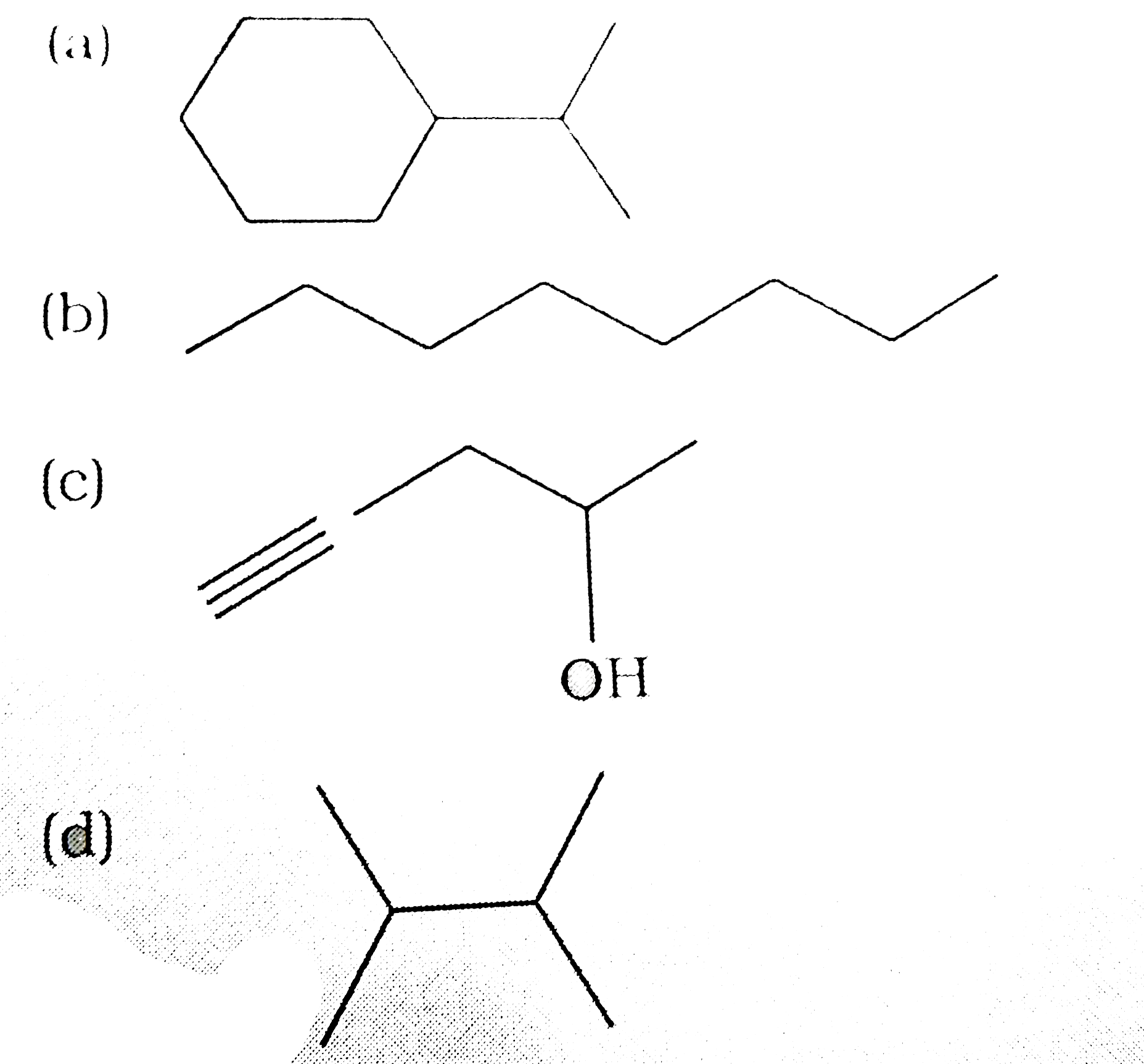Complete Solutions to SOLVED EXAMPLE of chapter ORGANIC CHEMISTRY- SOME BASIC PRINCIPLES AND TECHNIQUES of Class 11 book with complete answers and questions
| Class 11 | CHEMISTRY |
| Chapter | ORGANIC CHEMISTRY- SOME BASIC PRINCIPLES AND TECHNIQUES |
| NCERT | SOLVED EXAMPLE |
| Number Of Questions | 27 |
| Academic Year | 2023-24 |
How many σ and π bonds are present in each of the following molecules?
(a) `HCequiv"CC"H=CHCH_(3)` (b) `CH_(2)=C=CHCH_(3)`02:18View SolutionWhat is the type of hybridzation of each carbon in the following compounds?
`CH_(3)Cl` (b) `(CH_(3))_(2)CO` (c ) `CH_(3)CN` (d) `HCONH_(2)` (e) `CH_(3)CH=CHCN`04:53View SolutionWrite the hybridised state of carbon in the following compounds and shapes of each of each of the molecules.
(a) `H_(2)C=O` (b) `CH_(3)F` (c ) `H-C-=N`02:33View SolutionExpand each of the following condensed formulas into their complete structural formulas.
`(a) CH_(3)CH_(2)COCH_(2)CH_(3)`
`(b) CH_(3)CH=CH(CH_(2))_(3)CH_(3)`01:50View SolutionFor each of the following compounds, write a condensed formula and also their bond-line formula.
`(a) HOCH_(2)CH_(2)CH_(2)CH(CH_(3))CH(CH_(3))CH_(3)`
(b) `NequivC-overset(OH)overset(|)(CH)-CequivN`01:54View SolutionExpand each of the following bond-line formulas to show all the atoms including carbon and hydrogen
 03:03View Solution
03:03View SolutionStructures and IUPAC names of some hydrocarbons are given below. Explain why the names given in the parentheses are incorrect.
`underset(["and not 3,4,7-Trimethyloctane"])underset(2,5,6- "Trimethyloctane")(CH_(3)-underset(CH_(3))underset(|)(CH)-CH_(2)-CH_(2)-underset(CH_(3))underset(|)(CH)-underset(CH_(3))underset(|)(CH)-CH_(2)-CH_(3))`
`underset(["and not 5-Ethyl-3-methylheptane"])underset("3-Ethyl-5-methylheptane")(CH_(3)-CH_(2)-underset(CH_(2)CH_(3))underset(|)(CH)-CH_(2)-underset(CH_(3))underset(|)(CH)-CH_(2)-CH_(3))`03:01View SolutionWrite the IUPAC names of the compounds i-iv from their given structures.
(i) `overset(1)CH_(3)-overset(2)CH_(2)-underset(OH)underset(|)(overset(3)CH)-overset(4)CH_(2)-overset(5)CH_(2)-underset(CH_(3))underset(|)(overset(6)CH)-overset(7)CH_(2)-overset(8)CH_(3)`01:05View SolutionWrite the IUPAC names of the compounds i-iv from their given structures.
`underset(6)CH_(3)-underset(5)CH_(2)-overset(O)overset(||)underset(4)C-underset(3)CH_(2)-overset(O)overset(||)underset(2)C-underset(1)CH_(3)`01:03View SolutionWrite the IUPAC names of the compounds i-iv from their given structures.
`underset(6)CH_(3)-overset(O)overset(||)underset(5)C-underset(4)CH_(2)-underset(3)CH_(2)-underset(2)CH_(2)-underset(1)COOH`01:16View SolutionWrite the IUPAC names of the compounds i-iv from their given structures.
`underset(6)CHequivunderset(5)C-underset(4)CH=underset(3)CH-underset(2)CHequivunderset(1)CH_(2)`01:37View SolutionDerive the structure of (i) 2-Chlorohexane, (ii) Pent-4-en-2-ol, (iii) 3- Nitrocyclohexene, (iv) Cyclohex-2-en-1-ol, (v) 6-Hydroxy- heptanal.
04:12View SolutionWrite the structural formula of:
(a) o-Ethylanisole, (b) p-Nitroaniline,
(c) 2,3 - Dibromo -1 - phenylpentane,
(d) 4-Ethyl-1-fluoro-2-nitrobenzene.02:43View SolutionUsing the curved-arrow notation, show the formation of reactive intermediates when the following convalent bonds undergo heterolytic cleavage :
(a) `CH_3 - S - CH_3`
(b) `CH_3 - CN`
( c) `CH_3 - Cu` .02:59View SolutionCategorise the following molecules/ions ad nucleophile or electrophile.
(1) `HS^(Ө)`
(2) `BF_3`
(3) `C_2H_5O^(Ө)`
(4) `(CH_3)_3 ddot N`
(5) `C1^(Ө)`
(6) `CH_3 - overset (oplus) C = O`
(7) `:overset (Ө) NH_2`
(8) `overset (oplus) N O_2`.03:54View SolutionIdentify electrophilic centre in the following :
(1) `CH_3CH=O`
(2) `CH_3-CN`
(3) `CH_3 I`.02:15View SolutionWhich bond is more polar in the following pairs of molecules ?
(a) `H_3C-H,H_3C-Br`,
(b) `H_3C-NH_2,H_3C-OH`
( c) `H_3C-OH,H_3C-SH`.02:22View SolutionIn which `(C - C)` bond of `(H_3 overset (3)C - overset (2) C H_2 - overset (1) CH_2 - Br)`, the inductive effect is expected to be the least ?
02:37View SolutionWrite resonance structures of `CH_(3)COO^(-)` and show the movement of electrons by curved arrows.
05:21View SolutionWrite the resonance structures of `(1) CH_3 COO^(Ө)` and `(2) CH_2 = CH - CHO`. Indicate the relative stability of the contributing structures.
05:21View SolutionExplain why the following two structures `(I)` and `(II)` cannot be the major contributors to the real structures of `CH_3COOCH_3`.
 .02:08View Solution
.02:08View SolutionExplain why `(CH_(3))_(3)overset(+)C`is more stable than `CH_(3)overset(+)CH_(2)` and `CH_(3)` is the least stable cation
07:28View SolutionOn complete combustion, 0.246 g of an organic compound gave 0.198g of carbon dioxide and 0.1014g of water. Determine the percentage composition of carbon and hydrogen in the compound
02:03View SolutionIn Dumas’ method for estimation of nitrogen, 0.3g of an organic compound gave 50mL of nitrogen collected at 300K temperature and 715mm pressure. Calculate the percentage composition of nitrogen in the compound. (Aqueous tension at 300K=15 mm)
08:40View SolutionDuring estimation of nitrogen present in an organic compound by Kjeldahl’s method, the ammonia evolved from 0.5 g of the compound in Kjeldahl’s estimation of nitrogen, neutralized 10 mL of 1 M `H_(2)SO_(4)`. Find out the percentage of nitrogen in the compound.
05:58View Solution0.15 gm of an organic compound gave 0.12 gm of silver bromide by the carius method. Find the percentage of bromine in the compound.
03:07View SolutionIn sulphur estimation, 0.157 g of an organic compound gave 0.4813 g of barium sulphate. What is the percentage of sulphur in the compound?
01:28View Solution
SOLVED EXAMPLE questions and complete solutions for chapter ORGANIC CHEMISTRY- SOME BASIC PRINCIPLES AND TECHNIQUES of NCERT CHEMISTRY(HINGLISH) of Class 11
